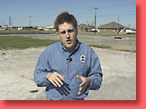|
H a r o l d B r o o k s
My name is Harold Brooks and I’m a research meteorologist at NOAA’s National Severe Storms Laboratory (NSSL) in Norman, Oklahoma. Right now, I’m involved in two primary areas of research: 1) severe thunderstorm climatology and impacts (when and where they occur around the world and how they affect people) and 2) forecast evaluation (what is a good forecast?). Officially, I’m also the "technical supervisor" for a small group at NSSL, but as my group members would testify, I don’t do a whole lot in that role and the only part of my job I don’t like is the employee evaluation at the end of the year. HOW
I GOT WHERE I AM:
I loved math, science, and sports from the time I was young. I started learning how to do long division because I needed to know how to compute batting averages and earned run averages. By the time I got to college, I knew I wanted to be a scientist and I majored in physics and math at William Jewell College in Liberty, Missouri. While I was there, I got the opportunity to go to Cambridge University for a year and study Archaeology and Anthropology, which was quite a lot of fun, but I don’t think I’d want to do it for a career. I started getting seriously interested in the atmosphere when I went to NASA’s Goddard Institute for Space Studies and Columbia University in New York City for a summer program in 1981. While I was there, I made some global climate model simulations of the climate at the last glacial maximum, 18,000 years ago. I was invited to go back to Columbia for graduate school and I got my Master’s degree modeling the transport of volcanic aerosols in the stratosphere. A lot of things were going on at the time, personally and professionally, and I decided I needed to leave Columbia for my Ph.D. I was also thinking I wanted to work on something with a little shorter time frame and closer
to the Earth than volcanic aerosols. I ended up at the University of Illinois, where I modeled supercell thunderstorms (the kind of storms that make the strongest tornadoes) and worked on the question of why some thunderstorms produce tornadoes and others don’t. During my stay at Illinois, I got the chance to go to a meeting in Halifax, Nova Scotia, where I met a number of Canadian weather forecasters who were interested in the "tornado/no tornado" question. One thing led to another and I got invited to give a talk at a workshop they were having a few months later and ever since, I’ve gotten to make a trip or so per year to Canada, usually to talk to their forecasters. It also started my involvement with what we call "operational" forecasting-the day-to-day forecasting of the weather.
|


